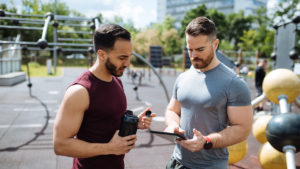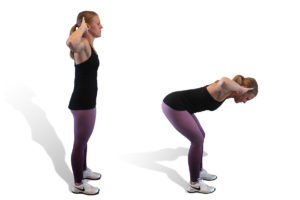Program Design/Ex Rx/Sample Workouts
Resistance Training During Pregnancy Benefits the Unborn Child
Review study shows that pre-natal strength training is good for mother and child. Aerobic exercise during pregnancy is often recommended, while strength training benefits are overlooked. A new review study…
Knee Osteoarthritis and Inactivity
New research shows that physical activity eases symptoms of knee OA, yet few exercise. Fit pros can educate those that cope with knee osteoarthritis that while they may want to…
Designing Exercise Programs With Clients
New research suggests that participants should help with adapting and designing exercise programs to their own preferences.
Sample Exercises: Deadlifts and Deadshifts
Look for ways to add these sample deadlifts and deadshifts to your training programs. Your body, your clients and your baby will thank you.
Complex Training Workout for Athletes
To make the most of athletic training, take a look at complex training, which combines strength training with plyometric drills.
Fit to Travel: Exercises for Seniors
Programming exercises for seniors is more important than ever, especially now that travel is opening up again, but your clients may not have kept up with their workouts over this last year. Here are some great ways to prepare your active agers for more adventure.
Stretches After Sitting All Day
Encourage your fitness class participants to use these simple stretches after sitting all day to help their muscles return to a relaxed state.
Training Loads for Women Over 40
Personal trainers often have female clients over the age of 40 who have similar complaints about losing muscle mass and gaining body fat. Although these changes aren’t unexpected and can be a normal part of the aging process, they are not inevitable. In fact, the right resistance-training program can positively affect body composition by reducing fat, maintaining and building muscle, and increasing strength in this population.
A Strong Diaphragm for a Strong Core
When you think about exercising core muscles, do you remember your diaphragm? Its two main functions involve breathing and biomechanics, and it’s one of the most important muscles for maintaining intra-abdominal pressure (Nelson 2012). Intra-abdominal pressure is like a weight belt applied from the inside. If your body can’t regulate this pressure, you may experience poor motor control and lack of spinal stability. Plus, when the diaphragm is not properly engaged, other muscles must compensate, increasing your risk of injury.
Sample Class: Seated Exercises for Older Adults
Older adults are more susceptible to deficits in cardiovascular fitness, muscle mass, strength and power, which may ultimately lead to losses in physical function. The following chair-based format focuses on improving outcomes for older participants, especially those who may need the support of a chair during exercise. Ready, Set, Sit! offers the variety of three 15-minute training segments (cardiovascular, high intensity and strength/power), while targeting important components that boost overall function.
Complex Training: Pairing for Power
If you work with athletes, you’ve likely run into the challenge of how to incorporate power components into their already-packed training schedules. Whether you’re working with a clutch outfielder, a center or a lineman, your client’s athletic skills need refinement, and power is one aspect that requires attention. Trainers typically program resistance training to develop strength and plyometric drills to improve speed.
Sample Class: Every Minute on the Minute
If you enjoy teaching (and doing) high-intensity classes, this workout is for you! The “every minute on the minute” (EMOM) protocol is fun, fast-moving and challenging. You start a predetermined number of reps at the top of a minute and rest for the time you have left until the next minute begins.
Gamify the Fitness Class Cooldown
There are 5 minutes left in your class, the energy is high, and everyone is sweating and having a great time. As you wrap up the last set, participants cheer and exchange high-fives to celebrate another awesome workout. You turn the music down to prepare for the cooldown, then you look up—and notice that people are packing up and leaving.
Sample Class: Tabata for Every Rider
This indoor cycling routine introduces Tabata-inspired intervals that provide a great workout for both beginner and advanced cyclists.
Try Different Plank Variations in Your Class
Forearm plank, side plank, plank with hip dips—all are group exercise favorites. The plank is one of the most familiar and effective choices for core work, and it’s an easy addition. However, how many times can you program that same old plank? Fortunately, with a little creativity, a basic plank can be amazingly versatile. Just add simple movements and a little resistance to make an already challenging move even more interesting and effective.
Sample Class: EMOM Workout
If you enjoy teaching high-intensity classes, this fun, fast-moving and challenging EMOM workout is for you!
Using Anti-Rotation to Coach Rotation
When you watch someone hit a golf ball, throw a punch or simply retrieve groceries from the car, it’s evident that human movement occurs in all three planes of motion. A review of basic core anatomy—major muscles attached to the trunk, above the ischial tuberosity and below the superior aspect of the sternum—reveals that 87.5% of the core muscles are oriented either diagonally or horizontally, and one action that these muscles perform is rotation (Santana 2000).
Winning Combination: Mindfulness and Strength
If you teach high-intensity classes, you may have noticed that many of your devoted students don’t take advantage of gentler options, such as restorative yoga, foam rolling or low-impact classes. Cross-training is necessary for peak fitness and reduced injury risk, yet persuading participants to try something new or different is not so easy. This class, Mindfulness and Strength, prioritizes mindfulness and flexibility.
Reaching Millennial Moms
Are you leaning into the rise of millennial moms? These women are part of a generation that’s expected, as of this year, to surpass baby boomers as the nation’s largest age demographic. The 83 million 17- to 36-year-old “millennial” men and women in the United States—combined with Generation Xers—account for 80% of the fitness dollars spent in clubs (Lexington Law 2019; Les Mills 2017). Already fitness consumers, millennial women are becoming mothers.
A Barre-Cardio-Core Class
When you take the strong, efficient movements of barre and mix in cardiovascular intensity and a comprehensive core routine, you get a winning combination for a full-body workout that appeals to a wide variety of people. Traditional barre classes use small, repetitive movements from a standing posture to work on balance while strengthening the lower body. Simultaneously, the upper body receives graceful range-of-motion benefits.



















